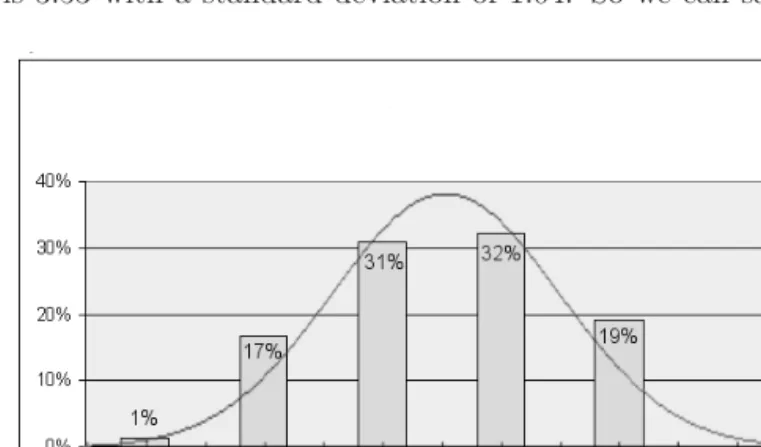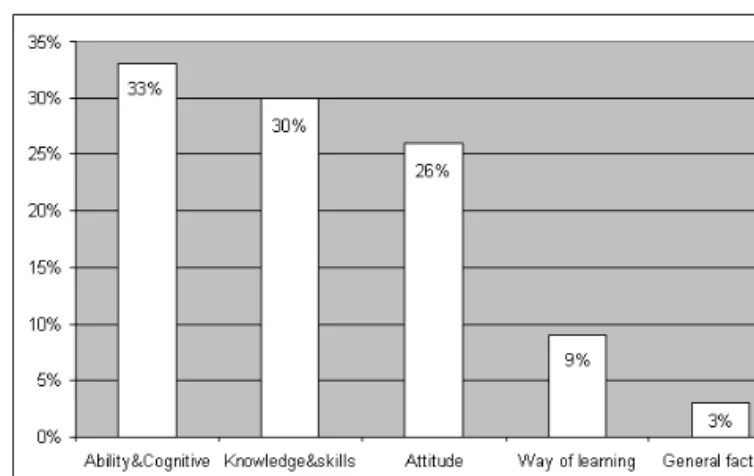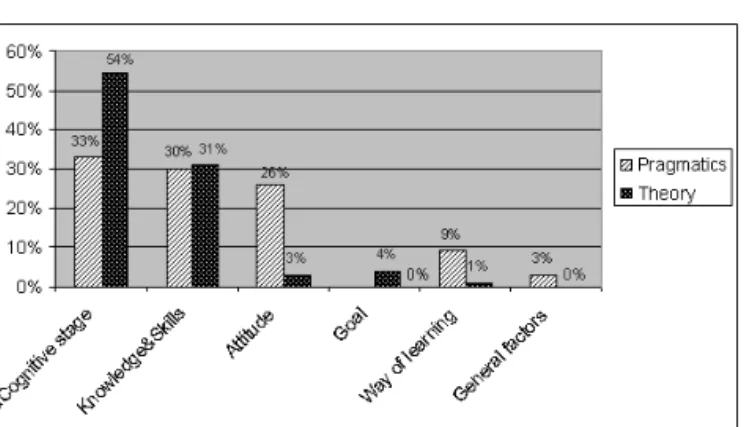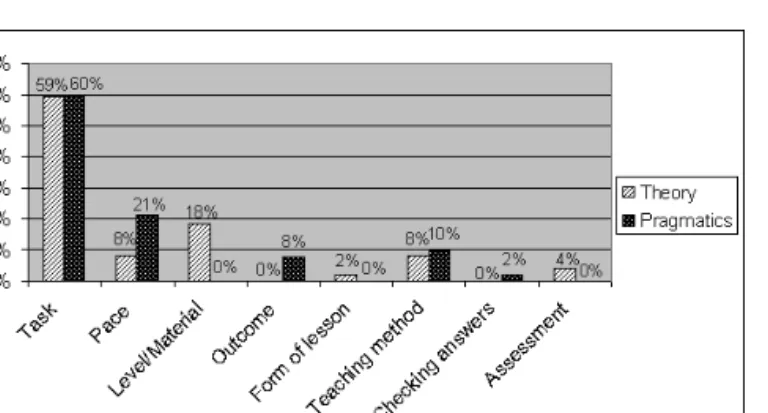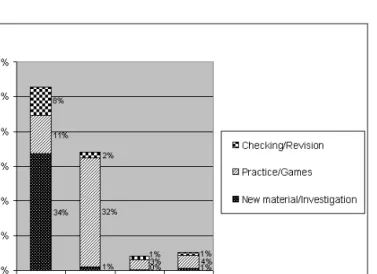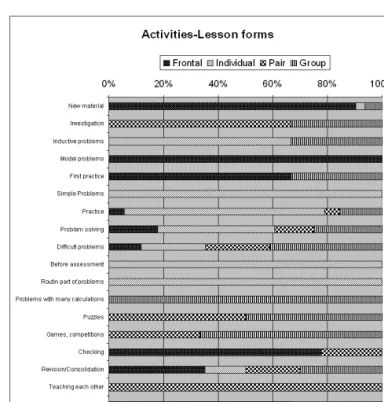(2006) pp. 189–205
http://www.ektf.hu/tanszek/matematika/ami
Mathematics teachers and differentiation - results of a survey concerning Hungarian
secondary schools
Réka Szász
Alfréd Rényi Institute of Mathematics e-mail: reka@renyi.hu
Submitted 25 December 2005; Accepted 3 November 2006
Abstract
Differentiation is a method where teachers adapt their teaching to the needs of individual students. In Hungary it had not been an issues until recently, although it is becoming a more and more acute need. The paper presents the findings of a survey, the aim of which was to examine the present situation of differentiation in Hungarian secondary schools.
Keywords: differentiation MSC:97C90
1. Introduction
There is a diversity of students in each and every classroom: students differ in ability, aims, learning styles and many other factors. Hence teachers must adapt their teaching methods to the needs of individual students, which process is called differentiation. This involves setting activities where students may do different tasks, or tasks in a different way, and also using a variety of teaching styles, which ensures that each student profits from some of them. To realize this, teachers need appropriate professional skills, and also practical help, such as appropriate teaching material, or an assistant teacher.
In Hungary, differentiation has not been an issue until recently, although every teacher uses it intuitively to some degree. With increasing differences among stu- dents, the greater emphasis on equal opportunities, and the introduction of the two-level secondary final examination it is becoming a more and more acute need.
The present National Curriculum emphasizes the need for differentiation both in
189
the description of its general principles and in its standards for Mathematics teach- ing [1]. However, the National Institute of Public Education (Országos Közoktatási Intézet) found in a survey on secondary mathematics teaching in 2003 that although teachers differentiate, they face both professional and practical difficulties concern- ing the issue [16].
This paper presents the findings of a survey, the aim of which was to examine the present situation of differentiation in Hungarian secondary schools. As the two- level final examination is in the centre of these issues, I introduce the acronyms CLFE and ELFE for the core and the extended level final examinations respectively.
2. Differentiated teaching - literature review
Here I give a short summary of the theory of differentiated teaching. A more detailed presentation can be found in [8].
2.1. The diversity of students
Results of several surveys, such as the international PISA [22], and the national MONITOR [21] showed that variation in mathematical attainment has increased in Hungary. Czeglédy [6] finds that there is a strikingheterogeneityin students’
mathematics achievement not only between, but within classes, as well.
There are many factors underlying mathematical achievement, which educa- tors need to bear in mind when trying to cope with the diversity of students.
Cangelosi [4] describes the following factors:
• Mathematical competence – Mathematical ability – Cognitive stage
– Prior mathematical learning – Communication skills
• Attitude towards mathematics – Motivation
– Self-confidence
• Way of learning – Learning style – Study skills
• General factors – Gender
– Social background – Special needs
2.2. Differentiation as an answer to diversity
An obvious answer to diversity is ability grouping, which is strongly present in Hungarian secondary schools. There is much evidence, however, that this does not solve the problem ([14] and [11]), and it reinforces social inequalities [18]. The alternative to teaching the whole class as a unit is differentiation, ’the process of identifying, with each learner, the most effective strategies for achieving agreed targets’ ([19], p. 129). We can realize differentiation from the following aspects [7]:
• Content
– Task: students work on different tasks
– Pace of learning: students work on the same tasks, but proceed at a different pace
– Outcome: students work on a task that can be answered on different levels
• Way of learning
– Lesson form: students can work individually, in pairs, or groups si- multaneously
– Teaching method: using a different form of dialogue – Use of aids: the quantity and nature of aids can be different
• Checking and assessment: checking work with different thoroughness, setting different requirements
Differentiation requires a great amount of attention and work from teachers, but there are certain tools they can make use of. It is essential to have an appropriate curriculum, which identifies core material, to be acquired by every student, and enrichment topics for those who are able to move faster [12] (in Hungary, core topics include the CLFE requirements, and enrichment topics can be ELFE requirements, cultural topics, etc.). The most important help is atextbookthat is built on the curriculum and takes every aspect of differentiation into consideration [12]. Other tools areassistant teachers(student teachers or volunteers) [9] andcomputers [2], which make all of the above mentioned aspects of differentiation easier. I should also add that certainlesson forms are more appropriate for differentiation than others. Individual work and homogeneous pairing or grouping is a way to realise differentiation by task or pace, while heterogeneous pairs and groups facilitate differentiation by outcome. In the latter case, students either solve subtasks of different difficulty, or take roles that require different skills. They can also teach each other: more advanced students deepen their knowledge by explaining to their peers, while these benefit from their explanation. Whole-class work, on the other hand, is quite inappropriate for differentiation [15].
Finally, as educators cannot differentiate all the time and in every aspect of teaching, they should teach in a way that is appropriate to a diversity of
students. This means using a variety of instructional methods and materials [17], and real-life context, which is able to bridge the gap between different students [18].
3. Teachers in Hungary and differentiation
This section presents the results of the survey, which was carried out in 2005, and involved a representative set of secondary mathematics teachers in Hungary (details of methodology are described in the next section). The aim was to find out how acute the problem of diversity is, how teachers handle it, and what kind of help they need most.
3.1. Diversity of students
First, I wanted to know about the extent and nature of heterogeneity in class- rooms, as this is the major motivation for differentiation. Teachers turned out to teach in class sizes with an average of 20. In years 9 and 10 many of them teach whole classes with more than 35 students, but many other schools are fortunate enough to have smaller groups from the beginning. In years 11 and 12 groups are usually smaller, especially special (fakultációs) groups preparing for the ELFE.
I also asked teachers to rate theheterogeneityof their groups from 1 (homoge- neous) to 5 (very heterogeneous). Table 1 shows the results and a fitted bell-curve.
The mean is 3.53 with a standard deviation of 1.04. So we can say that teachers
Table 1: Heterogeneity of groups.
perceive their groups to be quite heterogeneous. Some teachers voiced difficulties caused by heterogeneity in words, too:
• It is almost impossible in groups of 35 students [to handle students with different aims]
• In year 9 I give separate worksheets to those behind and good students. It takes a lot of time to design, correct, and assess these.
• It is difficult [to handle student differences]. I have to work more.
• Sometimes I feel that it is unmanageable! [about handling differences]
I also asked teachers whatfactorsof difference cause the greatest difficulties in teaching. Let me first present Cangelosi’s [4] categories adding a percentage value of corresponding factors in teachers’ answers (the value of the main categories includes answers relating to the category as a whole besides those relating to sub- categories):
• Mathematical competence 63%
– mathematical ability 32%
– cognitive stage 1%
– prior mathematical learning 25%
– communication skills 3%
• Attitude towards mathematics 26%
– motivation 18%
– self-confidence
• Way of learning 8%
– learning style 7%
– study skills 1%
• General factors 3%
– gender
– social background 2%
– special needs
As mathematical competence has the biggest weight, and because many teachers referred to skills that cannot be related to any of its sub-categories, I divided it into ability&cognitive stage and knowledge&skills (including Cangelosi’s prior mathe- matical learning, communication skills, and mathematical competence in general).
Table 2 shows teachers’ answers clustered this way. I find these results important for two main reasons. On one hand, they help in devising effective aids to differ- entiation. On the other hand, it draws attention to factors that teachers do not recognise enough, or at all. They tend to look at their students either from the
Table 2: Differences between students.
side of output (knowledge&skills), or they simplify input as being mostly ability and attitude (and they often regard negative attitude the fault of the student).
However, some of the factors they recognise less are such that they could have a positive influence on, such as communication skills (very important in the new final examination), self-confidence, and study skills. It would also be important for teachers to be more aware of students’ social background and learning styles, in order to motivate them effectively and to find suitable ways to teach them. It is natural that teachers do not mention special needs students, as they are not usually integrated into secondary teaching at the moment, but later teachers will have to care for them, too.
Another interesting aspect of teachers’ view on student differences appears in their definitions of differentiation, where a lot of them indicate some kind of factor as a motive for differentiation. I put these in the same clusters adding goal as a new category (although this is part of motivation I kept it separate to show its appearance). Table 3 compares the importance of factors when teachers look at differences pragmatically (report on their students) and theoretically (giving a definition). It is apparent that in theory teachers recognise a much narrower spectre of differences. While knowledge&skills have the same weight as before, the importance of input factors shifts almost exclusively to ability. However, goal appears as a new factor, which teachers probably recognise because of the two- level final examination. The fact that they do not list it in pragmatics shows that probably they do not distinguish between their students according to their goals, which becomes apparent in the next section indeed.
On the whole, the task seems to be to widen teachers’ view on the factors of student differences. To this teacher training (both pre- and in-service) can have the greatest contribution. Although this is outside the reach of this study, I would like to state is an important future goal. But this fact also highlights the importance
Table 3: Teachers’ view on student differences.
of designing teaching materials that serve a wide variety of students even without teachers specifically aiming at this.
3.2. Extent and ways of differentiation
To the first glance the results of this question are positive: two-thirds of teachers differentiate to some extent. Let us take a closer look. The questionnaire had two questions strongly related to differentiation, a pragmatic one ("How do you handle these differences?"), and a theoretical one ("What do you think the term differentiation means?"). As in the case of diversity, the pragmatic question is closer to real teaching, and it gives more information, so I will start with that and analyse the results more deeply.
It is difficult to calculate a reliable percentage of teachers who differentiate, but the answers suggest that 63% of teachers asked do differentiate, and 29% do not differentiate in their lessons (but 17% among them differentiate in homework, or give extra-curricular remediation or enrichment classes). It is more informative to look at all the methods they mention, and compare the frequency of these, as shown in Table 4. Again, numbers suggest that differentiation is widely used to handle differences both in and outside lessons, and teachers also use other methods to handle differences. Before analysing them, let us take a closer look at what kind of answers these terms cover. Differentiation by task usually means that stronger stu- dents work on difficult problems while weaker ones practice or get further teacher explanation. Differentiation by pacemeans that faster students get extra problems to solve. Differentiation by outcome/rolemeans using a lesson form where students profit from the same activity in a different way, e.g groupwork, study-pairs, or pre- sentations. Differentiation by teaching methods includes techniques when teachers show other solutions to stronger, pitfalls to weaker students, or keep stronger con- trol over less diligent ones. Motivation includes keeping students’ interest, helping them to have a sense of achievement, giving good points, or convincing them that
Table 4: Handling differences.
hard work leads to success. Helping the group as a whole includes re-teaching and revision, extra practice, answering questions, or interpreting problems together.
To analyse ways of differentiation it is interesting to compare the above prag- matic answers to teachers’ theoretical answers, as shown in Table 5. (Note that although teachers worded the answers to the two questions quite differently, the re- sults are very similar). Differentiation by task is naturally the most popular way of differentiation, followed by differentiation by pace. Differentiation by level/material can be realised by task and pace, I will deal later with the fact that it is only present in theory. Differentiation by outcome, although used in practice, is not present in theoretical answers, probably because these are methods teachers use incidentally.
Although from the above answers it seems that teachers recognise differentiation by lesson form in theory only, from the answers to other questions it is obvious that they use it in practice, too1.
A relatively high number of teachers mention differentiation by teaching meth- ods both in theory and practice, while that by use of aids is missing, maybe because the scarce use of aids in secondary school, anyway. Differentiation by checking answers is a way that would deserve more emphasis, although teachers might use
1In their answers to the question about lesson forms (later in this section) 3% of teachers explain that stronger students work in pairs on difficult problems while others work with the teacher, or individually.
Table 5: Ways of differentiation.
it when differentiating by task without mentioning it explicitly. Differentiation by assessment is only recognised in theory, this is mainly a problem concerning groups preparing for two different levels of the final examination.
Let me now examine the different tools of differentiation. As thedifferentiated curriculum is concerned, it seems that teachers do not use it widely. The first evidence is the fact that differentiation by task/material only appears in theory.
From the descriptions I presented for differentiation by task and by pace, it is also clear that when students are involved in different activities, they work on problems of different difficulty within the same material. Teachers do not mention teaching different material to students, or even giving strong students problems that lead to new material. This fact is also made clear by the lack of differentiation by assessment in practice. Another strong evidence for the lack of differentiated curriculum can be seen from the following question:
Do you have a group where students want to reach different goals (e.g a year 11 or 12 group which involves students preparing for both levels of the final exam)?
If yes, how do you handle the situation?
30% of teachers answered yes, and these all teach groups preparing for both lev- els for the final examination. Table 6 summarises their methods. Teachers who differentiate do it by giving different problems to students. Those who do not dif- ferentiate prepare for the level most students need, or to a level in between the two.
The high percentage of those who do not differentiate in a situation where the need is so evident, clearly shows their inability to use a differentiated curriculum.
Only 11% of teachers have someoneassistingin part of their lessons, and this is always a teacher trainee. Only 28% of teachers use a computer, and part of them only as a tool for representation through a projector. Many of those who do not, refer to the absence of appropriate facilities.
Concerningmethods appropriate for a diversity of students, let us look back at results shown in the previous subsection. I found that Ability&Cognitive
Table 6: Groups preparing for two levels.
Stage, Knowledge&Skills, and Attitude are the categories that weigh most, while Way of learning and General Factors also have a role. Let us examine the connection of these to their methods of differentiation. With students differing in the first two big categories, that is inmathematical competence, clearlydifferentiation by content is appropriate, which teachers use a lot. However, Table 7 shows that teaching is more appropriate for weaker student than for stronger ones. These numbers were
Table 7: Adjusting to diverse needs in mathematical competence.
all inferred from the way teacher handle differences. Those who devote more time to weaker students differentiate by task or by pace, but leave stronger students working on extra problems while they spend extra time with weaker ones. Those who adjust material to the level of weaker students either say so explicitly, or belong to teachers whohelp the group as a whole by re-teaching, revision, extra practice,
answering questions, and interpreting problems together. In sum, teachers who favour one level with their teaching methods all help weaker students, but the rest seem to care equally about their students.
Teachers seem to handle differences in attitude effectively, asmotivating is an important tool. Differentiation byteaching methodsseems appropriate for students with a different way of learning, or differences in general factors, of course there are many other ways to do this.
On the whole, the recognition of factors and the connected methods of handling differences seem to correlate a lot. We can interpret this statement both in a positive and in a negative way. From an optimistic point of view, teachers find appropriate methods to handle student differences. From a pessimistic one, teachers naturally handle factors of difference they recognise, hence it is a great problem that, as I observed before, that they are not aware of many of them. Finally, let me examine thelesson formsteachers use, as this tells us a lot about the extent and way they differentiate. I asked teachers to tell how much part of the lesson they spend with each form, and what kind of activities they use these for. Table 8 shows each activity type within a lesson form as a percentage of all lesson time. Most time
Table 8: Lesson forms - Activities.
is spent with whole-class work, and this is basically the only way students acquire new material, check answers or revise. This means, that teachers think their person as an active participant is indispensable in such activities. From a general point of view, this is a problem because student activity is quite low during whole-class work. And from the present point of view, it makes differentiation impossible [15].
Practice is mainly individual, when, as we saw before, teachers use differentiation by task or pace. A quite large proportion of practice is done with the whole class,
partly in form of solving model problems, but some of the teachers simply use this lesson form for practice, too. In my opinion it would be favourable if teachers used less whole-class, and more pair- and groupwork, thus enabling their students to work according to their needs, and also to substitute teachers by taking a role of explainer [ibid.].
Now let us look at activities more closely. Table 9 shows each activity type and teachers’ favoured lesson forms. Teaching new material, as we saw before,
Table 9: Activities - Lesson forms.
is mostly whole-class, but some teachers also let their students investigate and solve inductive problems. As we look at different problem solving activities, we see that while the group advances from model problems to first practice, simple problems, and practice, teachers let the control out of their hands and trust their students doing individual work and a little pair- and groupwork. Then, as they get to problem solving and difficult problems, they either get the control back, or let students help each other in pairs and groups. The second version is of course more favourable for differentiation. Then, we can see that teachers favour certain lessons forms with certain activities. For instance, they trust their students to solve routine parts of problems individually, they want them to share work with problems requiring many calculations, and favour pair- and groupwork with fun,
such as puzzles, games and competitions. Checking work is mostly whole-class, but teachers recognise the other forms for revision and consolidation, and a few also the effectiveness of peer-teaching. Finally, it is interesting that teachers prefer whole-class and individual work with larger or weaker groups, presumably because it is easier for them to keep control that way. However, it would be worth teaching their students how to work in pairs and groups and accept less control, as that would mean more activity and attention (from peers) for their weaker students, and members of large groups, too [15].
4. Methods of data collection and analysis
4.1. Designing the questionnaire
The content of the questionnaire was based on the theory presented in Section 2. The first question,
1. Have you heard of the term differentiation (or differentiated teaching)? If yes, what do you think it means?
wanted to find out the theoretical knowledge of teachers about differentiation. The next two questions,
2. What is the average class size you teach?
3. (a) How heterogeneous are the classes you teach? 1 2 3 4 5 (1: homogenous, 5: very heterogeneous)
(b) What kind of differences cause the greatest difficulties in mathematics lessons?
aimed at finding out the acuteness of the need for differentiation. Question 4 asked about how teachers differentiate in practice,
4. How do you handle these differences?
and question 5 asked about the specific case of preparing for the two-level final examination:
5. Do you have a group where students want to reach different goals (e.g a year 11 or 12 group which involves students preparing for both levels of the final exam)? If yes, how do you handle the situation?
Questions 6, 7 and 9 asked if specific aids are available or used:
6. Which textbooks do you use?
7. Do you use a computer in your lessons? If yes, how often and what for?
8. How much, and for what activities do you use the following lesson forms:
whole-class work:
individual work:
pairwork:
groupwork:
9. Does it happen that someone attends to students besides you during lessons (assistant, teacher trainee, parent, etc.)?
4.2. Methods of data collection
The first step of designing the survey was selecting a representative sample of Hungarian secondary schools. I selected 25 schools (4% of all 636 secondary schools) using the database of the Information Office of Education (Közoktatási Információs Iroda) [10]. The database can be searched according to school type (secondary in the present case), county and maintainer (community council, city council, council of town of county rack, county council, capital council, capital district council, church, foundation, state university, etc). My aim was to select a sample where the number of schools from each county and maintainer is proportional to the corresponding number of all secondary schools. The number of secondary schools in each county is about 25, except for the following cases. In four counties it is less, but I could pair them up so as to get around 25 together. In the county of Pest the number is double, and in the capital it is 7 times as much. So I selected one school from each average size county, 1 from each pair of small ones, 2 from Pest and 7 from the capital. I selected these schools randomly: selected a random number between 1 and the length of the list, and chose the school with that serial number in the list. Then I had to make sure that the sample was representative of maintainers. If a maintainer was over-represented, I dropped a random school of that maintainer, and selected a random school (regardless of maintainer) from the county dropped. After repeating this step a few times I obtained a set that was fully representative.
The next step was to have mathematics teachers of the selected schools fill out the questionnaire. Larger schools teaching more students should have had a greater weight, which would naturally happen as they would have more mathematics teach- ers asked. So I contacted the head of mathematics department in each school, and sent them the appropriate number of questionnaires. Teachers of 21 schools (84%
of the ones asked) filled out the questionnaire, 78 teachers altogether.
4.3. Methods of analysis
The analysis of questions 2, 3/a, 6, 7 and 9 is quite obvious. The methods used with the rest are presented in the order that follows their analysis in the previous section. Student differences appeared in question 3, and partly in question 1, and were presented in Table 2 and Table 3. For each question, I counted the differences
that occurred in the answers, and calculated the ratio of the number of occurrences and the total number of occurrences. Hence the percentages obtained were a weight in that factor within all factors, and not a percentage of teachers who listed that factors. When making clusters of categories, these numbers better reflected the importance of each category.
When analysing differentiationbased on questions 1, 3 and 4, (Table 4 and Table 5) values were calculated as a percentage of teachers using each method, as I was interested not only in weights, but the ratio of teachers using certain methods.
These values, however, are not additive, so for clustering I had to recalculate values.
Lesson forms were analysed based on question 8, and represented in . First I averaged percentages teachers gave for time spent on each lesson form. Within each form, I counted the occurrences of activities, and calculated their ratio within all occurrences. I used these ratios as estimates of time spent with these activities within a certain lesson form. Multiplying activity ratios within a form with the time ratio of the given lesson form, I obtained an estimate of the percentage of lesson time spent with the given activity in the given form. These values are presented in Table 9. Table 8 presents lesson forms within each activity. Unlike in the previous table, I used a 100% stacked chart. Although this is less informative then a plain bar chart, as it does not show how time spent with each activity relates to each other, I used it because otherwise some bars would have been too small to see well.
5. Conclusion
On the whole, I found that a large part of teachers differentiate, and in many ways they differentiate effectively. However, I also found ground for change.
First, most teachers do not differentiate the curriculum, although this would be essential with the two level final examination, as students study together until year 10, and sometimes even after that. Then, teachers are not aware of many factors in which students differ, and hence probably do not teach appropriately to these. And some do not even teach appropriately to students differing in the most recognised factor, mathematical competence, as they favour weaker students with their teaching methods. Finally, examining lesson forms, I found that they use whole-class work in the greatest part of lesson time, which renders differentiation impossible. At the same time, they scarcely use pair- and groupwork, although these are very favourable forms for differentiation.
Many of these problems stem for teaching traditions in Hungary, which are quite achievement-oriented and favour whole-class teaching [3]. Part of the change is needed to be made in teachers’ attitude, which is the task of teacher training (both pre- and in-service) [13]. The other, equally important part of the change would be in the materialistic situation of teaching, that is, the circumstances and aids available for teacher, such as printed and electronic teaching materials, assis- tant teachers, IT facilities. There are initiatives to give such practical help. One example is a set of textbook that has appeared recently with the aim of supporting differentiation (Mathematics by Czeglédy, Hajdu, Hajdu, Kovács & Róka) [8] and
[5]. Another example is an initiative to have teacher trainees assisting in classrooms [20].
References
[1] A Kormány 243/2003. (XII.17.) Kormányrendelete a Nemzeti alaptanterv ki- adásáról, bevezetéséről és alkalmazásáról,
www.om.hu/main.php?folderID=391&articleID=1478&ctag=articlelist&iid=1.
[2] Ainly, J., Adjusting to the newcomer: Roles for the computer in mathematics class- rooms, inIssues in Mathematics Teaching, Peter Gates (Ed.), Routledge, London, (2001).
[3] Benda, J., A kooperatív pedagógia szocializációs sikerei és lehetőségei Magyarorszá- gon I.,Új Magyar Pedagógiai Szemle, September, (2002), 26-37.
[4] Cangelosi, J. S.,Teaching mathematics in secondary and middle school: an inter- active approach, (2nd ed.), Merill, Englewood Cliffs, (1996).
[5] Czeglédy, I., Hajdu, S., Hajdu, S. Z., Róka, S., Kovács, A.,Matematika, A Felzárkóztatástól a Tehetséggondozásig, Budapest, Műszaki Könyvkiadó, (2003).
[6] Czeglédy, I., Matematika tantárgy mérés 7. osztályban,Miskolci Pedagógus, 26, (1990), 10-16.
[7] Czeglédy, I., Orosz, Gy., Szalontai, T., Szilák, A., Matematika tantár- gypedagógia I., Bessenyei György Könyvkiadó, Nyíregyháza, (2000).
[8] Czeglédy, I., Szász, R., The mathematics textbook as an aid to differentiation: A first Hungarian example,Teaching Mathematics and Computer Science, 3/1, (2005), 35-53.
[9] Hedrick, W. B., Pre-service teachers tutoring one-on-one within the school setting, Reading Research and Instruction38/3, (1999), 211-19.
[10] Közoktatási Információs Iroda, www.kir.hu/intezmeny.
[11] Kulik, C. C., Kulik, J. A., Effects of Ability Grouping on Secondary School Students: A Meta-analysis of Evaluation Findings,American Educational Research Journal, 19/3, (1982), 415-428.
[12] Meiring, S. P., Rubenstein, R. N., Schultz, J. E., de Lange, J., Chambers, D. L.,Curriculum and Evaluation Standards for School Mathematics, Addenda Se- ries, Grades 9-12: A Core Curriculum, National Council of Teachers of Mathematics, Reston, Virginia, (1992).
[13] Poór, Z., Pedagógusképzés és -továbbképzés a változó pedagógusszerepek tükrében, Új Magyar Pedagógiai Szemle, May (2003), 50-54.
[14] Slavin, R. E., Achievement Effects of Ability Grouping in Secondary Schools: A Best Evidence Synthesis,Review of Educational Research, 60/3, (1990), 471-499.
[15] Slavin, R. E., Research on Cooperative Learning and Achievement: What We Know, What We Need to Know Contemporary Educational Psychology, Review of Educational Research, 21/1, (1996), 43-69.
[16] Somfai, Zs., A matematikatanítás helyzete a középiskolában - A 2003-as obszervá- ciós felmérés tapasztalatai,Országos Közoktatási Intézet,
www.oki.hu/oldal.php?tipus=cikk&kod=kozepfoku-somfai-matematikatanitas [17] Stiff, L. V., Johnson, J. L., Johnson, M. R., Cognitive Issues in Mathematics
Education, in: Research Ideas for the Classroom: High School Mathematics, (P. S.
Wilson, ed.), Macmillan, New York, (1993).
[18] Stiff, L. V., Introducion, Reaching All Students: a Vision of Learning Mathemat- ics, in: Reaching All Students with Mathematics, G. Cuevas and M. Driscoll (Eds.), The National Council of Teachers of Mathematics, Virginia, (1993), 3-16.
[19] Strading, R., Saunders, L., Weston P., Differentiation in Action: a Whole School Approach for Raising Attainment, HMSO, London, (1991).
[20] Szász, R., The mathematics teacher trainee as an assistant teacher,Teaching Math- ematics and Computer Science, 3/2 (2005), 295-306.
[21] Vári, P.,Monitor ’95, Országos Közoktatási Intézet, Budapest, (1997).
[22] Vári, P.,PISA-vizsgálat 2000, Műszaki Könyvkiadó, Budapest, (2003).
Réka Szász
Alfréd Rényi Institute of Mathematics P.O. Box 127
H-1053 Budapest Hungary
